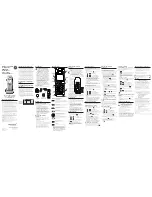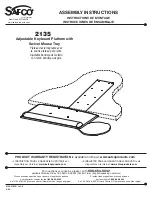
HIGHLIGHTS OF PRESCRIBING INFORMATION
These highlights do not include all the information needed to use LANTUS safely and
effectively. See full prescribing information for LANTUS.
LANTUS
®
(insulin glargine [rDNA origin] injection) solution for subcutaneous injection
Initial U.S. Approval: 2000
——————————————
INDICATIONS AND USAGE
——————————————
LANTUS is a long- acting human insulin analog indicated to improve glycemic control in adults and
children with type 1 diabetes mellitus and in adults with type 2 diabetes mellitus. (1)
Important Limitations of Use:
•
Not recommended for treating diabetic ketoacidosis. Use intravenous, short-acting insulin
instead.
————————————— DOSAGE AND ADMINISTRATION —————————————
•
The starting dose should be individualized based on the type of diabetes and whether the
patient is insulin-naïve (2.1, 2.2, 2.3)
•
Administer subcutaneously once daily at any time of day, but at the same time every day. (2.1)
•
Rotate injection sites within an injection area (abdomen, thigh, or deltoid) to reduce the risk
of lipodystrophy. (2.1)
•
Converting from other insulin therapies may require adjustment of timing and dose of LANTUS.
Closely monitor glucoses especially upon converting to LANTUS and during the initial weeks
thereafter. (2.3)
———————————— DOSAGE FORMS AND STRENGTHS ————————————
Solution for injection 100 units/mL (U-100) in
•
10 mL vials
•
3 mL cartridge system for use in OptiClik (Insulin Delivery Device)
•
3 mL SoloStar disposable insulin device (3)
———————————————
CONTRAINDICATIONS
———————————————
Do not use in patients with hypersensitivity to LANTUS or one of its excipients (4)
————————————— WARNINGS AND PRECAUTIONS —————————————
•
Dose adjustment and monitoring: Monitor blood glucose in all patients treated with insulin.
Insulin regimens should be modified cautiously and only under medical supervision (5.1)
•
Administration: Do not dilute or mix with any other insulin or solution. Do not administer
subcutaneously via an insulin pump or intravenously because severe hypoglycemia can occur
(5.2)
•
Do not share reusable or disposable insulin devices or needles between patients (5.2)
•
Hypoglycemia: Most common adverse reaction of insulin therapy and may be life-threatening
(5.3, 6.1)
•
Allergic reactions: Severe, life-threatening, generalized allergy, including anaphylaxis, can
occur (5.4, 6.1)
•
Renal or hepatic impairment: May require a reduction in the LANTUS dose (5.5, 5.6)
———————————————
ADVERSE REACTIONS
———————————————
Adverse reactions commonly associated with Lantus are:
•
Hypoglycemia, allergic reactions, injection site reaction, lipodystrophy, pruritus, and rash. (6.1)
To report SUSPECTED ADVERSE REACTIONS, contact sanofi-aventis at 1-800-633-1610 or
FDA at 1-800-FDA-1088 or
www.fda.gov/medwatch.
———————————————
DRUG INTERACTIONS
———————————————
•
Certain drugs may affect glucose metabolism, requiring insulin dose adjustment and close
monitoring of blood glucose. (7)
•
The signs of hypoglycemia may be reduced or absent in patients taking anti-adrenergic drugs
(e.g., beta-blockers, clonidine, guanethidine, and reserpine). (7)
————————————
USE IN SPECIFIC POPULATIONS
————————————
•
Pregnancy category C: Use during pregnancy only if the potential benefit justifies the potential
risk to the fetus (8.1)
•
Pediatric: Has not been studied in children with type 2 diabetes. Has not been studied in
children with type 1 diabetes
<
6 years of age (8.4)
See 17 for PATIENT COUNSELING INFORMATION and FDA-approved patient labeling
Revised: 04/2010
FULL PRESCRIBING INFORMATION: CONTENTS
*
1.
INDICATIONS AND USAGE
2.
DOSAGE AND ADMINISTRATION
2.1
Dosing
2.2
Initiation of LANTUS therapy
2.3
Converting to LANTUS from other insulin therapies
3.
DOSAGE FORMS AND STRENGTHS
4.
CONTRAINDICATIONS
5.
WARNINGS AND PRECAUTIONS
5.1
Dosage adjustment and monitoring
5.2
Administration
5.3
Hypoglycemia
5.4
Hypersensitivity and allergic reactions
5.5
Renal impairment
5.6
Hepatic impairment
5.7
Drug interactions
6.
ADVERSE REACTIONS
6.1
Clinical trial experience
6.2
Postmarketing experience
7.
DRUG INTERACTIONS
8.
USE IN SPECIFIC POPULATIONS
8.1
Pregnancy
8.3
Nursing Mothers
8.4
Pediatric Use
8.5
Geriatric Use
10.
OVERDOSAGE
11.
DESCRIPTION
12.
CLINICAL PHARMACOLOGY
12.1
Mechanism of Action
12.2
Pharmacodynamics
12.3
Pharmacokinetics
13.
NONCLINICAL TOXICOLOGY
13.1
Carcinogenesis, Mutagenesis, Impairment of Fertility
14.
CLINICAL STUDIES
16.
HOW SUPPLIED/STORAGE AND HANDLING
16.1
How supplied
16.2
Storage
16.3
Preparation and handling
17.
PATIENT COUNSELING INFORMATION
17.1
Instructions for patients
17.2
FDA approved patient labeling
*Sections or subsections omitted from the full prescribing information are not listed
FULL PRESCRIBING INFORMATION
1.
INDICATIONS AND USAGE
LANTUS is indicated to improve glycemic control in adults and children with type 1 diabetes mellitus
and in adults with type 2 diabetes mellitus.
Important Limitations of Use:
•
LANTUS is not recommended for the treatment of diabetic ketoacidosis. Intravenous short-acting
insulin is the preferred treatment for this condition.
2.
DOSAGE AND ADMINISTRATION
2.1
Dosing
LANTUS is a recombinant human insulin analog for once daily subcutaneous administration with
potency that is approximately the same as the potency of human insulin. LANTUS exhibits a relatively
constant glucose-lowering profile over 24 hours that permits once-daily dosing.
LANTUS may be administered at any time during the day. LANTUS should be administered
subcutaneously once a day at the same time every day. The dose of LANTUS must be individualized
based on clinical response. Blood glucose monitoring is essential in all patients receiving insulin
therapy.
Patients adjusting the amount or timing of dosing with LANTUS, should only do so under medical
supervision with appropriate glucose monitoring
[see Warnings and Precautions (5.1)
.]
In patients with type 1 diabetes, LANTUS must be used in regimens with short-acting insulin.
The intended duration of activity of LANTUS is dependent on injection into subcutaneous tissue
[see
Clinical pharmacology (12.2)]
. LANTUS should not be administered intravenously or via an insulin
pump. Intravenous administration of the usual subcutaneous dose could result in severe hypoglycemia
[see Warnings and Precautions (5.3)]
.
As with all insulins, injection sites should be rotated within the same region (abdomen, thigh, or deltoid)
from one injection to the next to reduce the risk of lipodystrophy
[See Adverse Reactions (6.1)].
In clinical studies, there was no clinically relevant difference in insulin glargine absorption after
abdominal, deltoid, or thigh subcutaneous administration. As for all insulins, the rate of absorption, and
consequently the onset and duration of action, may be affected by exercise and other variables, such
as stress, intercurrent illness, or changes in co-administered drugs or meal patterns
.
2.2
Initiation of LANTUS therapy
The recommended starting dose of LANTUS in patients with type 1 diabetes should be approximately
one-third of the total daily insulin requirements. Short-acting, premeal insulin should be used to satisfy
the remainder of the daily insulin requirements.
The recommended starting dose of LANTUS in patients with type 2 diabetes who are not currently
treated with insulin is 10 units (or 0.2 Units/kg) once daily, which should subsequently be adjusted to
the patient’s needs.
1
Lantus PI.April.2010









































